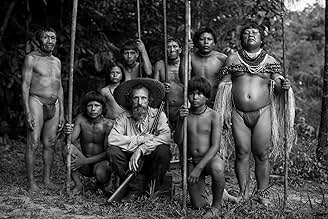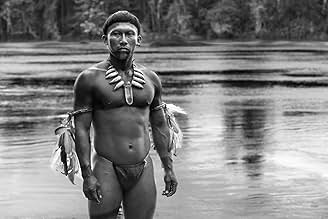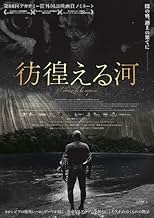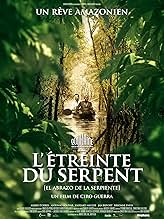VALUTAZIONE IMDb
7,8/10
24.989
LA TUA VALUTAZIONE
La storia della relazione tra Karamakate, sciamano amazzonico e ultimo sopravvissuto del suo popolo, e due scienziati che lavorano insieme nel corso di quarant'anni per cercare in Amazzonia ... Leggi tuttoLa storia della relazione tra Karamakate, sciamano amazzonico e ultimo sopravvissuto del suo popolo, e due scienziati che lavorano insieme nel corso di quarant'anni per cercare in Amazzonia una sacra pianta curativa.La storia della relazione tra Karamakate, sciamano amazzonico e ultimo sopravvissuto del suo popolo, e due scienziati che lavorano insieme nel corso di quarant'anni per cercare in Amazzonia una sacra pianta curativa.
- Candidato a 1 Oscar
- 46 vittorie e 32 candidature totali
Antonio Bolívar
- Old Karamakate
- (as Tafillama-Antonio Bolívar Salvador)
Miguel Dionisio Ramos
- Manduca
- (as Yauenkü Miguee)
Jesús Rodríguez
- Borracho Cohiuano
- (as Jesús Rodríguez)
Trama
Lo sapevi?
- QuizThe scene where a man is praised to be the Messiah is based on an actual event.
- Citazioni
Young Karamakate: Knowledge belongs to all. You do not understand that. You are just a white man.
- ConnessioniFeatured in Starfilm (2017)
- Colonne sonoreEmbrace Of The Serpent
(Theme from Original Motion Picture Soundtrack)
by Nascuy Linares
© 2016 Plaza Mayor Company, Ltd.
Recensione in evidenza
For 350 years, Spain built a vast empire in South America based on the labor and exploitation of the Indian population, forcing them to accept Christianity while decimating their culture, religion, and even their language. In the late 19th and early 20th Centuries, "rubber barons" rounded up all the Indians and forced them to tap rubber out of the trees in rainforest zones leading to slavery and human rights abuses. Winner of the top Director's Fortnight Award at Cannes and Colombia's submission to the Oscars in the Best Foreign Film category, Ciro Guerra's ("The Wind Journeys") Embrace of the Serpent (El abrazo de la serpiente) provides a powerful insight into the effects of colonialism on an indigenous population.
The film, in which nine different languages are spoken, follows two interconnected stories based on the travel journals of two Amazonian explorers thirty years apart, German scientist Theodor Koch-Grunberg (Jan Bijvoet, "Borgman") and American plant enthusiast Richard Evans Schultes (Brionne Davis, "Avenged"). Both men are seeking the Yakruna plant to discover its powerful ability to heal. The two explorers are accompanied by the Amazonian shaman Karamakate (Niblio Torres as a young man and Antonio Bolivar as the elder) not only to find the sacred plant for research purposes but to learn deeper truths about themselves and the nature of reality. Karamakate, the last surviving member of his tribe, guards the secrets of Yakruna, a last symbol of independence for his people.
Filmed in black and white by cinematographer David Gallego ("Cecilia"), it is the first film to be shot on location in the Amazon in thirty years and its gorgeous kaleidoscope of rivers and forests, and the blending of time creates a surreal, dreamlike atmosphere, fortified by native songs and chants. As the film begins, a young Karamakate, armed with a spear and dressed in native attire, stands menacingly as a boat approaches the shore containing the German scientist and his companion Manduca (Yauenku Migue), a native dressed in white man's clothing.
Manduca asks the shaman to cure the explorer who is very sick, but Karamakate, who is familiar with the destructive nature of the white man, refuses. When Theo tells him, however, that he has seen survivors of his people and will take him to them, the young shaman agrees as long as the white man follows his "prohibitions" about disturbing the natural flow of the jungle. The two scientists, Theo in 1909 and Evan in 1940, follow the same path and explore the same places drastically changed over the years. Karamakate, as he did with Theo, acts as Evan's guide and considers himself as a "chullachaqui," an empty shell of a human being, and must become a man once more in tune with nature.
Two scenes stand out. After a night of singing and dancing with a native group and demonstrating Western technology, Theodor becomes angry when a member of the group wants to keep his compass in exchange for goods. To rationalize his anger, he tells Karamakate that owning a compass would disturb their traditions of finding locations through the sun and stars, but the shaman tells him "You cannot forbid them to learn. Knowledge belongs to all men." The other scene is one of pure horror when a priest (Luigi Sciamanna, "Secreto de Confesion") at a Spanish mission is found brutally whipping his young students until Theodor intervenes.
Despite an element of religious madness that feels out of sync with the tone of the film, Embrace of the Serpent soars when its focus is on spiritual awareness. The shaman tells both scientists the need to unburden themselves of their material possessions and explore the mystery of consciousness alone without their physical and psychological baggage. They cannot be cured of their illness, he tells them, because they have forgotten how to dream. After Evan ingests a native plant following a heated exchange with Karamakate, a montage of brilliant, swirling colors pushes the boundary of what we think is real and allows us to remember how to dream.
The film, in which nine different languages are spoken, follows two interconnected stories based on the travel journals of two Amazonian explorers thirty years apart, German scientist Theodor Koch-Grunberg (Jan Bijvoet, "Borgman") and American plant enthusiast Richard Evans Schultes (Brionne Davis, "Avenged"). Both men are seeking the Yakruna plant to discover its powerful ability to heal. The two explorers are accompanied by the Amazonian shaman Karamakate (Niblio Torres as a young man and Antonio Bolivar as the elder) not only to find the sacred plant for research purposes but to learn deeper truths about themselves and the nature of reality. Karamakate, the last surviving member of his tribe, guards the secrets of Yakruna, a last symbol of independence for his people.
Filmed in black and white by cinematographer David Gallego ("Cecilia"), it is the first film to be shot on location in the Amazon in thirty years and its gorgeous kaleidoscope of rivers and forests, and the blending of time creates a surreal, dreamlike atmosphere, fortified by native songs and chants. As the film begins, a young Karamakate, armed with a spear and dressed in native attire, stands menacingly as a boat approaches the shore containing the German scientist and his companion Manduca (Yauenku Migue), a native dressed in white man's clothing.
Manduca asks the shaman to cure the explorer who is very sick, but Karamakate, who is familiar with the destructive nature of the white man, refuses. When Theo tells him, however, that he has seen survivors of his people and will take him to them, the young shaman agrees as long as the white man follows his "prohibitions" about disturbing the natural flow of the jungle. The two scientists, Theo in 1909 and Evan in 1940, follow the same path and explore the same places drastically changed over the years. Karamakate, as he did with Theo, acts as Evan's guide and considers himself as a "chullachaqui," an empty shell of a human being, and must become a man once more in tune with nature.
Two scenes stand out. After a night of singing and dancing with a native group and demonstrating Western technology, Theodor becomes angry when a member of the group wants to keep his compass in exchange for goods. To rationalize his anger, he tells Karamakate that owning a compass would disturb their traditions of finding locations through the sun and stars, but the shaman tells him "You cannot forbid them to learn. Knowledge belongs to all men." The other scene is one of pure horror when a priest (Luigi Sciamanna, "Secreto de Confesion") at a Spanish mission is found brutally whipping his young students until Theodor intervenes.
Despite an element of religious madness that feels out of sync with the tone of the film, Embrace of the Serpent soars when its focus is on spiritual awareness. The shaman tells both scientists the need to unburden themselves of their material possessions and explore the mystery of consciousness alone without their physical and psychological baggage. They cannot be cured of their illness, he tells them, because they have forgotten how to dream. After Evan ingests a native plant following a heated exchange with Karamakate, a montage of brilliant, swirling colors pushes the boundary of what we think is real and allows us to remember how to dream.
- howard.schumann
- 7 ott 2015
- Permalink
I più visti
Accedi per valutare e creare un elenco di titoli salvati per ottenere consigli personalizzati
- How long is Embrace of the Serpent?Powered by Alexa
Dettagli
- Data di uscita
- Paesi di origine
- Siti ufficiali
- Lingue
- Celebre anche come
- Embrace of the Serpent
- Luoghi delle riprese
- Aziende produttrici
- Vedi altri crediti dell’azienda su IMDbPro
Botteghino
- Budget
- 1.400.000 USD (previsto)
- Lordo Stati Uniti e Canada
- 1.329.249 USD
- Fine settimana di apertura Stati Uniti e Canada
- 50.955 USD
- 21 feb 2016
- Lordo in tutto il mondo
- 3.217.212 USD
- Tempo di esecuzione2 ore 5 minuti
- Colore
- Mix di suoni
- Proporzioni
- 2.35 : 1
Contribuisci a questa pagina
Suggerisci una modifica o aggiungi i contenuti mancanti

Divario superiore
By what name was El abrazo de la serpiente (2015) officially released in India in English?
Rispondi

























